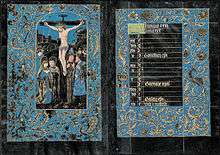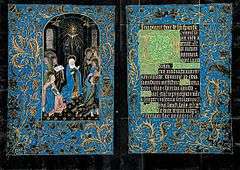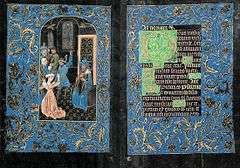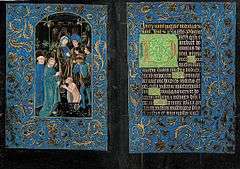Black Hours (Morgan Library)

The Black Hours, MS M493 (French: Livre d'heures noir, German: Schwarzes Stundenbuch) is an illuminated book of hours usually dated to c 1475, originating in Bruges. No records survive of its creators or original owners, but the quality and expensive rarity of its production and its uniquely dark tone suggest commission by privileged and sophisticated members of the Burgundian laity. It is usually attributed to the circle of Willem Vrelant, the leading Flemish illuminator of his generation. The manuscript is now in the collection of the Morgan Library & Museum, New York.
MS M493 is one of seven surviving Black books of hours, all of which date to mid to late 15th century Flanders.[1] The black and dark-blue backgrounds were achieved by immersing vellum in an iron-copper solution, with the parchment was presoaked in black ink.[2]
Description

.jpg)
The manuscript was probably intended for the first rank of nobility: the artwork is of a sophisticated, or at least unusual taste, and the pages are supposed by art historians to have carried an almost mystical aura for their medieval owners.[3] It consists of 121 sheets each measuring around 17 x 12cm, of which 14 contain full page miniatures, each placed opposite the beginning of one of the prayers, and which stylistically can be placed as between 1460 and 1475. There are 138 borders, with 15 large and several small signatures. Typically the biblical characters are clothed in a late Gothic dress. The initials are made from gold leaf on an emerald ground, and typically extend across lines of text.[4] The text is inscribed in Latin.[3] It is bound in tan pigskin and tied with oxidized silver clasps, probably added in the 19th century.[5] The colour scheme is mostly dark tones, with some reds, old rose, greens, grays, light flesh tones and whites. The dark and solemn appearance is in marked contrast to the bright colourisation found in even the highest quality books of the day and seems to reflect a rather gloomy and mournful outlook.[3]
The dramatic effect of the black and dark-blue backgrounds was achieved by immersing the vellum in an iron-copper solution before using gold or silver when applying the text. It is one of only seven known manuscripts in this style, all originating from the lower Netherlands. Because of the involved production process, the book would have been considerably more expensive and highly prized than conventional manuscripts. The underlying blue is made up of a number of variants of the hue, each of varying depths of colour.[6] The borders were ornamented exclusively in gold and are shaded mostly with black. They are decorated with yellow or gold filigree and extravagant foliage, including vines. The borders in places contain jagged acanthus scrolls, as well as birds, small animals, and grotesques, the latter similar to those found in the Viennese Hours.[6]

The Morgan book is the best preserved of the surviving black manuscripts, in large part because of its unusually thick parchment leaves which protected the lettering from the chemical effect of the black dye, and allowed the Morgan to keep it in codex form, rather than having to place leaves in acrylic panes, as is the case with the Vienna Black Prayer Book.[6] The manuscript has deteriorated in areas, especially in the black of the vellum, where flaking is evident.[7] According to the Morgan, the manuscript has been scheduled for treatment and repair.[5]
Attribution and commission
The Burgundian court of the time had a preference for dark, somber colourisation, and the extant works in this style were mostly commissioned for them.[8] They favored the contrast of black against gold and silver, a matter of taste that was reflected in their formal dress,[6] seen for example in Rogier van der Weyden's near contemporary Jean Wauquelin presenting his 'Chroniques de Hainaut' to Philip the Good. The Morgan miniatures are linked to a follower of Willem Vrelant due to the stylistic resemblance with some of the faces in his known works, while the angular and linear manner of painting the figure's clothes is also consistent with his style.[6]

MS M493 is usually attributed to a follower or member of the circle of the Flemish painter Willem Vrelant, the leading Flemish illustrator of his generation,[9] or less likely to the French painter Philippe de Mazerolles or the workshop of Liévin van Lathem.[5] It was probably commissioned for a member of the Burgundian nobility, but there is no family crest indicating the donor, who, given the expense of the book and its dating, must have been a high-ranking member of the court.[3]
Provenance
The manuscript was in the collection of Cardinal Nicholas Yemeniz from 1867 until sold it to Ambroise Firmin-Didot in 1871.[5] It was later acquired by Robert Hoe,[10] prior to its sale to the Pierpont Morgan Library in 1912.[3] It is now in the Morgan Library, New York, MS M493 is a masterpiece of Gothic manuscript illumination and "a book of unequaled luxury".[4]
Miniatures
The manuscript contains fourteen full-page miniatures depicting the life of the Virgin and Christ, usually placed opposite a calendar day from the liturgical year. The miniatures are all on the left (verso) side of the open leaves. Typically the biblical figures are dressed in late medieval or Gothic clothes or dress; in folio 76v David is dressed in the ceremonial robes of a 15th-century monarch.[6]

The best known miniature is that of the Crucifixion (folio 14v), the borders of which contain fantastical creatures and a peacock. The main figures are Mary and St John, flanked by two nobles engaged in discussion, probably questioning if the man on the cross were really the Son of God. The mourners' elegantly displayed expressions are of deep sadness and loss. Behind are the sparsely drawn walls of Jerusalem shown against a deep blue sky.[3]
Art historian Walter Ingo described folio 18v, depicting the Pentecost, or Descent of the Holy Spirit, as evidencing the "unusual, exquisite and precious overall effect of that is generated by using the technique of fixing an illumination on a piece of black dyed parchment".[3] Rinceau and flowery border decorations outline a depiction of Mary at the center of the court of the Apostles. The gilded "D" to the right references the opening letter of the Hours of the Holy Spirit.[3]
The following is a complete list of the miniatures:
- Folio 14v: The Crucifixion (opposite "Hours of the Cross")[11]
- Folio 18v: Pentecost (opposite "Hours of the Holy Spirit: Matins")[12]
- Folio 22v: Virgin and Child (opposite "Mass of the Virgin")[13]
- Folio 29v: Annunciation (opposite "Hours of the Virgin: Matins")[14]
- Folio 39v: Visitation (opposite "Hours of the Virgin: Lauds")[15]
- Folio 50v: Nativity ("Hours of the Virgin: Prime")[16]
- Folio 54v: Annunciation to the Shepherds (opposite "Hours of the Virgin: Terce")[17]
- Folio 58v: Adoration of the Magi (opposite "Hours of the Virgin: Sext")[18]
- Folio 62v: Massacre of the Innocents (opposite "Hours of the Virgin")[7]
- Folio 66v: Flight into Egypt (opposite "Hours of the Virgin")[19]
- Folio 72v: Coronation of the Virgin (opposite "Hours of the Virgin: Compline")[20]
- Folio 76v: David in prayer (opposite "Penitential Psalms and Litany")[21]
- Folio 93v: Resurrection of Lazarus (opposite "Office of the Dead: Vespers")[22]
- Folio 98v: Chanting of the Office of the Dead (opposite "Office of the Dead: Matins")[23]
-

Folios 22v/23r; Virgin and Child, opposite "Mass of the Virgin"
-

Folio 39v/40r: Visitation, opposite "Hours of the Virgin: Lauds"
-

Folios 62v/63r Massacre of the Innocents
-

Folios 66v/67r: Flight into Egypt
-

Folios 72v/73r: Coronation of the Virgin
-

Folios 93v/94r: Resurrection of Lazarus
References
Notes
- ↑ Ingo, 362
- ↑ Other extant works include the Black Hours of Galeazzo Maria Sforza (also known as the Black Hours of Charles the Bold) (ca. 1466–76) and the Hours of Mary of Burgundy (ca. 1477)
- 1 2 3 4 5 6 7 8 Walther, 372
- 1 2 "Das Schwarze Stundenbuch". New York: Old Manuscripts & Incunabula. Retrieved 11 October 2015
- 1 2 3 4 "Book of hours (MS M.493). "Morgan Library. Retrieved 4 October 2015
- 1 2 3 4 5 6 Walther, 373
- 1 2 "Fols. 62v–63r". Morgan Library. Retrieved 11 October 2015
- ↑ Walther, 363
- ↑ Walther, 480
- ↑ "The Coming Sale of part of the Robert Hoe Library". Lotus Magazine. Volume 3, No. 2, 1911. 35–43
- ↑ "Fols. 14v–15r". Morgan Library. Retrieved 11 October 2015
- ↑ "Fols. 18v–19r". Morgan Library. Retrieved 11 October 2015
- ↑ "Fols. 22v–23r". Morgan Library. Retrieved 11 October 2015
- ↑ "Fols. 29v–30r". Morgan Library. Retrieved 11 October 2015
- ↑ "Fols. 39v–40r". Morgan Library. Retrieved 11 October 2015
- ↑ "Fols. 50v–51r". Morgan Library. Retrieved 11 October 2015
- ↑ "Fols. 54v–55r". Morgan Library. Retrieved 11 October 2015
- ↑ "Fols. 58v–59r". Morgan Library. Retrieved 11 October 2015
- ↑ "Fols. 66v–67r". Morgan Library. Retrieved 11 October 2015
- ↑ "Fols. 72v–73r". Morgan Library. Retrieved 11 October 2015
- ↑ "Fols. 76v–77r". Morgan Library. Retrieved 11 October 2015
- ↑ "Fols. 93v–94r". Morgan Library. Retrieved 11 October 2015
- ↑ "Fols. 98v–99r". Morgan Library. Retrieved 11 October 2015
Sources
- Bousmanne, Bernard (ed). Black Book of Hours; Scientific commentary. New York: Pierpont Morgan Library, 2001
- Facsimile Ausgabe von Pierpont Morgan Library, New York, M. 493. Luzern: Faksimile Verlag Luzern, 2001
- Kren, Thomas; McKendrick, Scot. Illuminating the Renaissance: The Triumph of Flemish Manuscript Painting in Europe. CA: J. Paul Getty Museum, 2003. ISBN 978-08923-6703-0
- Walther, Ingo. Codices Illustres. Berlin: Taschen Verlag, 2001. ISBN 978-3-8228-6023-6
- Wieck, Roger. Painted Prayers: The Book of hours in Medieval and Renaissance Art. New York: George Braziller, 1997. ISBN 978-0-8076-1457-0
External links
| Wikimedia Commons has media related to Black hours - Morgan Lib M493. |